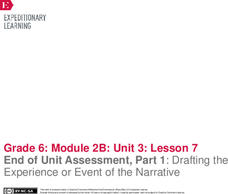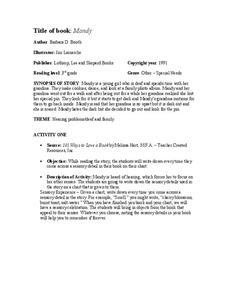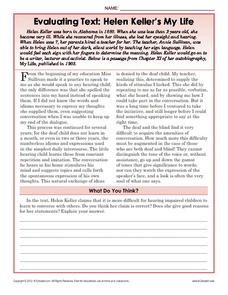Curated OER
Teaching Others About Being Deaf
Students read two articles about how college students taught others about being blind or deaf. In their school, they interview students with a physical challenge and use the internet to research how to write about those with...
Curated OER
Understanding Culture and Society (Grade 9--Deaf Community)
Ninth graders describe how characteristics of Deaf culture relate to ASL. They identify ways in which sign languages from other countries and ASL have influenced one another. Then invite a member of the Deaf community to speak to the...
Curated OER
Idioms in Everyday Language
Students describe idioms and their use in everyday language. They describe the difference between literal and idiomatic meanings. In groups, students use iPhoto to create books that explain and illustrate a variety of idioms describing...
Museum of Disability
Can You Hear a Rainbow?
Teach your class about compassion and empathy with Jamee Riggio Heelan's Can You Hear a Rainbow? As kids read about Chris, a boy who is deaf, they discuss the things he likes to do, as well as the ways he communicates with the world.
Curated OER
The Human Brain's Capacity for Language
Incorporate this slide show into your lecture about speech, language, psychology, or physiology. Addressing the structure of the brain as well as handedness and aphasia, the presentation could fit the needs of many different lecturers....
Curated OER
Semicolons
This is a fabulous worksheet! Grammar enthusiasts practice the art of correctly using a semicolon. They insert a semicolon to combine three independent clauses, three conjunctive adverbs to independent clauses, and to separate items in...
Museum of Disability
A Picture Book of Helen Keller
Teach your class about Helen Keller and her accomplishments with a reading comprehension lesson based on A Picture Book of Helen Keller by David A. Adler. As individuals read, they answer discussion questions about Helen Keller...
EngageNY
End of Unit Assessment, Part 1: Drafting the Experience or Event of the Narrative
Don't be tone deaf. Scholars study two photographs to better understand the concept of tone, so they can incorporate the literary device into their writing. Additionally, they draft the experience or event portion of their personal...
Curated OER
American Deaf Culture: A History of Language
Young scholars examine the relationship between language and culture in the Deaf Community. They discover the history of sign language and how it has been viewed in the past. They examine the Deaf community's beliefs and values.
Curated OER
Idioms in Everyday Language
Students create an iPhoto book exhibiting a variety of idioms that describe feelings. They take photos using a digital camera that show students exhibiting the feelings explained by the idioms.
Curated OER
Mandy
Third graders read Barbara D. Booth's, "Mandy" while noting each time they read a sensory detail. They read about the young girl in the story who is hard of hearing and determine how her other senses are heightened. Also, they determine...
Harper Collins
Amazing Women
Helen Keller became a teacher after her experience with Anne Sullivan, demonstrating to the world how valuable a dedicated mentor and determined spirit can be when overcoming adversity. Middle schoolers learn more about the influential...
K12 Reader
Evaluating Text: Helen Keller's "My Life"
Readers are asked to evaluate Helen Keller's claim, and the evidence she uses to support her argument, that it is more difficult for hearing impaired children to learn to talk with others.
Prestwick House
Wonderstruck
Wonderstruck, Brian Selznick's young-adult tale of two preteens who set alone on a quest, provides the text for the clues in a crossword puzzle. A great way to check on readers who were struck by the novel.
Curated OER
Creating a Picture Dictionary
Second graders create a reading, vocabulary,picture dictionary on the computer. They participate in becoming familiar with some basic capabilities of a word processor. They build vocabulary, spelling, and dictionary skills, reinforce...
Curated OER
Piercing the World of Silence
Students explore the sign language alphabet. They examine the difficulties faced by handicapped persons, and are introduced to Helen Keller, Anne Sullivan and The Miracle Worker.
Curated OER
My Deaf American Hero
Students study and discuss famous deaf people that are role models for students who are deaf. They research a famous deaf American and create a ten frame multimedia presentation to showcase the information.
Curated OER
Speech and Language Samples
Young scholars tell a story, describe a picture, share about a favorite toy from home and are recorded using an iPod with a voice recorder. They create a playlist of their voice and reading samples to illustrate progression over time.
Curated OER
American Sign Language Poster
In this American sign language worksheet, students learn the alphabet by analyzing this poster that has each letter with a picture of the hand in the correct position. There are no questions to answer.
Curated OER
Language for Speaking and Writing About Disabilities
In this disabilities sentences worksheet, students correct the sentences using people first language. Students correct 12 sentences about disabilities.
Curated OER
Religion and Deaf Education: The Contract Between Clerc and Gallaudet
Learners examine the issues surrounding the prevailing religious and cultural beliefs in the early 19th century United States and how they influenced the education of deaf people. They apply this information to modern day contexts.
Curated OER
You Too Can Haiku: How to Write a Haiku
Students explore language arts by writing their own poems. In this haiku lesson plan, students investigate the Japanese culture and their beautiful music, poetry and art. Students count the syllables in every line of a haiku poem and...
Curated OER
Elements of Fables
Students explore the attributes of fables. In this literature lesson, students read several fables and identify the moral lesson, characterization, and figurative language in each. Students then retell their favorite fables in their own...
Read Works
Famous Inventors Alexander Graham Bell: You Rang?
Scholars read a brief informational text about the famous inventor, Alexander Graham Bell and his invention of the telephone, then show what they know by way of eight questions—six multiple choice and two short answer.

























